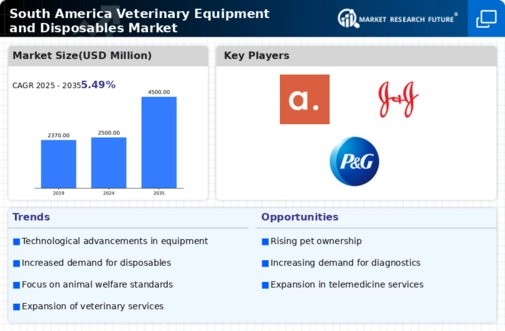Rising Pet Ownership
The increasing trend of pet ownership across South America significantly drives the Global South America Veterinary Equipment and Disposables Market Industry. As more households adopt pets, the demand for veterinary services and associated equipment rises. In 2024, the market is projected to reach 2500 USD Million, reflecting a growing awareness of pet health and wellness. This trend is particularly evident in urban areas where disposable income is higher, leading to increased spending on veterinary care. The rise in pet ownership not only boosts the demand for veterinary services but also necessitates a wider range of veterinary equipment and disposables.
Market Growth Projections
The Global South America Veterinary Equipment and Disposables Market Industry is poised for substantial growth, with projections indicating a market size of 4500 USD Million by 2035. This growth trajectory is underpinned by a compound annual growth rate of 5.49% from 2025 to 2035. The increasing demand for veterinary services, coupled with advancements in technology and rising pet ownership, suggests a robust market environment. The anticipated growth reflects the evolving landscape of veterinary care in South America, where both pet owners and veterinary professionals are increasingly prioritizing high-quality equipment and disposables.
Growing Awareness of Animal Health
There is a notable increase in public awareness regarding animal health and welfare, which significantly impacts the Global South America Veterinary Equipment and Disposables Market Industry. Educational campaigns and community outreach programs are fostering a culture of responsible pet ownership. As pet owners become more informed about the importance of regular veterinary visits and preventive care, the demand for veterinary services and associated equipment rises. This heightened awareness is expected to sustain market growth, with projections indicating a market size of 4500 USD Million by 2035, as more pet owners seek quality care for their animals.
Advancements in Veterinary Technology
Technological advancements in veterinary medicine are transforming the Global South America Veterinary Equipment and Disposables Market Industry. Innovations such as telemedicine, advanced diagnostic tools, and minimally invasive surgical equipment enhance the quality of veterinary care. These technologies improve treatment outcomes and streamline operations within veterinary practices. As a result, the market is expected to grow significantly, with projections indicating a rise to 4500 USD Million by 2035. The integration of technology in veterinary practices not only increases efficiency but also attracts more pet owners seeking high-quality care for their animals.
Government Initiatives and Regulations
Government initiatives aimed at improving animal health standards play a crucial role in shaping the Global South America Veterinary Equipment and Disposables Market Industry. Regulatory frameworks that promote animal welfare and veterinary care encourage investments in veterinary infrastructure. For instance, various South American countries are implementing policies that mandate regular health check-ups for pets, thereby increasing the demand for veterinary services and equipment. This regulatory support is likely to contribute to a compound annual growth rate of 5.49% from 2025 to 2035, reflecting a commitment to enhancing animal health and welfare across the region.
Expansion of Veterinary Clinics and Services
The expansion of veterinary clinics and services across South America is a key driver of the Global South America Veterinary Equipment and Disposables Market Industry. As urbanization continues, more veterinary practices are opening to meet the growing demand for pet care. This proliferation of clinics not only increases access to veterinary services but also drives the need for a diverse range of veterinary equipment and disposables. The market is anticipated to reach 2500 USD Million in 2024, reflecting this trend. The establishment of new clinics, particularly in underserved areas, is likely to enhance overall veterinary care and contribute to market growth.














Leave a Comment